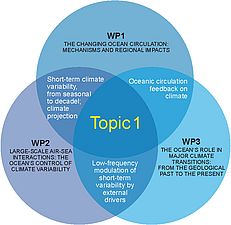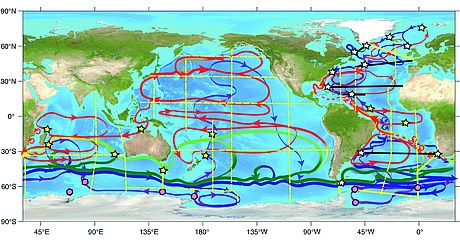Current Activities and Previous Work
Cutting-edge research on the nature of ocean circulation dynamics and its role in climate variability and change requires combining theoretical concepts, observations and modelling, a long-standing strength at GEOMAR.
We have utilized methodological advances in the development, improvement and application of state-of-the-art observational systems, including novel methods and autonomous platforms, such as moored ocean observatories, profiling floats, glider surveys, glider swarm experiments, direct microstructure observing systems and tracer release experiments.
The instrumental data is augmented by innovative geochemical (isotope), sedimentological and micropaleontological proxies obtained from marine archives, with a particular emphasis on the precise timing of past changes in the distribution and mixing of water masses. Reconstructed properties include not only basic hydrographic parameters, but also atmospheric circulation patterns, weathering regimes and the chemical state of the ocean.
A hierarchy of global ocean models has been developed, emphasising innovative “two-way nesting” techniques enabling efficient multi-decadal, eddy-resolving simulations, with particular applications to the large-scale effects of mesoscale ocean processes in the North Atlantic, the tropical oceans and key oceanic gateways, such as the Agulhas Leakage regime and the Indonesian Throughflow.
The ocean model hierarchy provides the nucleus for a sophisticated coupled ocean-atmosphere general circulation model, the Kiel Climate Model System, forming the basis for investigating ocean-atmosphere and ocean-biogeochemistry interactions. The individual model components are also run in uncoupled mode or replaced by versions with reduced physics to investigate the role of specific feedbacks and processes in the generation of climate variability, or the climate response to external forcing.
Research activities at GEOMAR have been focused on investigating (1) several prominent phenomena of ocean circulation variability and change in dynamically critical regions, (2) natural modes of climate variability on timescales from seasons to decades, and (3) past ocean-climate variability on timescales from centuries to millions of years, all representing major contributions to international research programmes such as CLIVAR, SPARC, OceanSites, GOOS, PAGES (see section 2.1.1).
Major foci of (1) include:
- Processes associated with deep water formation and its export in the western boundary current system of the subpolar North Atlantic, an important indicator of the Atlantic Meridional Overturning Circulation (AMOC). Variability of the AMOC is a focus of major collaborative programmes (e.g., BMBF-Nordatlantik, BMBF-RACE, BMBF-MiKlip, EU-EuroSites, EU-THOR, EU-NACLIM);
- Pathways and transports between the subtropics and the tropics, providing a key control on nutrient supply and oxygen availability - the main theme of the SFB754 - and which have been observed with arrays of moored and mobile observatories and simulated with high-resolution ocean models;
- Agulhas Leakage (the inter-oceanic exchange of warm, salty water from the Indian Ocean to the Atlantic Ocean), an important choke point of the global overturning circulation. Results of “nested” high-resolution model simulations suggest a significant influence on the AMOC during recent decades, thereby spurring international research programmes (e.g., EU-Gateways).
Major foci of (2) include:
- Study of various phenomena, regional and global, and associated climate variability on timescales from seasons to decades [e.g. El Niño/Southern Oscillation (ENSO), Tropical Atlantic Variability (TAV), Atlantic Multi-decadal Variability (AMV), Pacific Decadal Variability (PDV)], with a special emphasis on how they interact and may change in the future (e.g., EU-Ensembles, BMBF-MiKlip);
- New mode of inter-annual climate variability in the equatorial Atlantic, important for South American and African rainfall patterns, that is linked to deep ocean processes and poses a challenge for current models, since they do not capture this phenomenon (e.g., EU-AMMA, SFB 754);
- Coral records of climate indices, which help to understand the variability of tropical sea surface temperature (SST) and hurricane activity during the 19th and 20th century (e.g., EU-DYNAMITE).
Major foci of (3) include:
- Development and calibration of geochemical proxies, including trace metals and their stable and radiogenic isotopes obtained from sediments, skeletal carbonates and waters, building on the combination of analytical equipment, including various state-of-the-art mass spectrometers (TIMS, MC-ICP-MS, IR-MS, Quadrupole ICP-MS, and OES), and clean laboratories, which is unparalleled in marine research in Germany and allows the determination of concentrations and isotopic compositions of nearly all chemical elements from any kind of material;
- Identification of the physical, chemical and biological processes that triggered, amplified, sustained and terminated distinct climatic regimes in the past by combining paleo proxies with model studies;
- Control of plate-tectonic reorganizations on ocean circulation and on the distribution of heat and moisture between ocean basins, based on unique sediment material provided by the international ODP/IODP programme (e.g., DFG projects “Indonesian Gateway”, “PLIONAMOC”, “Panama Seaway”).
In addition, dedicated experiments at sea are performed to better understand ocean dynamics and its role in climate variability. The aim of the observations is twofold: 1) to validate the models and to assess hypotheses, as far as possible, about the mechanisms of climate variability (past and present), and 2) to improve the process understanding, ultimately resulting in a better representation or parameterization of these processes in climate simulations. Specifically, long-term measurements of deep winter mixing (convection) in the Labrador Sea are used to assess the ability of the Kiel Climate Model System to capture the role of the North Atlantic Oscillation (NAO) for driving decadal variability in the AMOC. Microstructure observing systems, including tracer release experiments, are utilized to quantify mixing in the ocean and to aid model development. The detailed study of past ocean-climate variability is used to assess climate models on timescales of centuries and longer and to distinguish between natural climate variability and anthropogenic change.
The topic builds on the joint expertise in theoretical, observational and modelling work, which provides us with a unique opportunity to study the ocean’s role in climate variability and predictability on a wide range of timescales. The ultimate goal is to understand the ocean’s role in shaping the regional pattern of climate change during the next decades and centuries. The research combines:
- cutting-edge instrumental observations
- innovative proxy development
- high-end numerical modelling
The research is organized in three work packages (WPs):
WP1: “The changing ocean circulation: mechanisms and regional impacts”
Regional climate change will strongly depend on ocean circulation changes. This WP addresses the underlying dynamics and how they impact key ocean variables of societal relevance, such as sea level, ocean CO2 uptake or fish stocks.
WP2: “Large-scale air-sea interactions: the ocean's control of climate variability"
The overall aim is to enhance seasonal to decadal climate prediction by advancing the understanding of large-scale ocean-atmosphere interactions, specifically in the tropics, improving the ocean components of the forecast systems and the representation of key atmospheric processes.
WP3: “The ocean’s role in major climate transitions: from the geological past to the present”
Records of past ocean circulation changes on a wide range of timescales provide fundamental information to describe and understand the natural variability of the ocean/climate system, against which model projections of future climate change can be assessed.
WPs 1 and 2 focus on the present state of the ocean and its current and future role in climate change, whereas WP3 mainly addresses past natural variations in climate and ocean circulation. The WPs are described in detail below.




